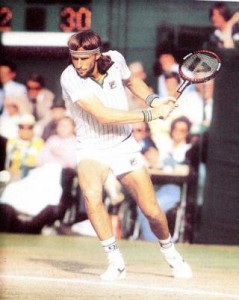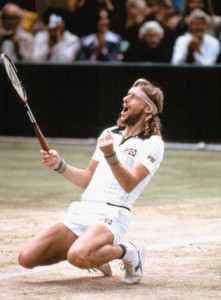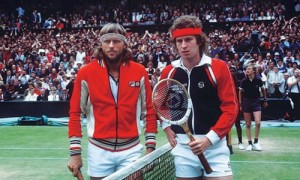The Beginning of the End for Bjorn Borg, Part One

Bjorn Borg was the face of professional tennis in the 1970s.
“My greatest point is my persistence. I never give up in a match. However down I am, I fight until the last ball. My list of matches shows that I have turned a great many so-called irretrievable defeats into victories.”
– Bjorn Borg
Former world No. 1 and Swedish teen sensation Bjorn Borg brought fame, fortune, and much-needed publicity to tennis in the mid-70s, when he began to play. His long blond hair, smoldering good looks, and rock-star status elevated tennis in the hearts of teenaged girls, if not the media corps.
There was a rhythm, a dance in his cat-like movements along the baseline as he swayed back and forth, shifting his weight from one foot to the other, tensed, ready to pounce as his opponent hit the ball over the net—like a cat playing with a mouse.
Borg understood the necessity of being in shape, of being as strong at the end of matches as you were at the beginning. This athleticism allowed him to dictate matches and gave him five Wimbledon Championships and six French Open Titles, often won back-to-back. Borg was the author of the modern game built on talent, but bolstered by strength and endurance.
His reign on these natural surfaces highlighted his strengths: his speed, his endurance, and his reaction time. His arsenal included a wicked two-handed backhand with heavy topspin that aided his accuracy, as well as an underrated serve.
Perhaps his greatest attribute was his coolness under pressure. Because of his unflappable concentration, Borg was nicknamed the “iceman,” or “ice borg.” He never let anything or anyone take him out of his game.
On Wimbledon grass and Roland Garros clay Borg seemed invincible, but Borg had an Achilles heel: A game that fell flat-footed in New York at the U.S. Open. Bjorn Borg was a finalist in New York four times, but never won.
U.S. Open 1975 – Semifinal
U.S. Open 1976 – Finalist
U.S. Open 1978 – Finalist
U.S. Open 1979 – Quarterfinal
U.S. Open 1980 – Finalist
U.S. Open 1981 – Finalist
Why was this the case? What was it about the U.S. Open that stopped Borg dead in his tracks?

Borg droppped to his knees in victory six times at the French Open and five times at Wimbledon, but never at the U.S. Open.
In 1976, a teenaged Borg played Jimmy Connors in the finals of the U.S. Open, which was then played on clay. Borg lost in four sets. 6-4, 3-6, 7-6 (11-9), 6-4. It was the loss of the third set tiebreaker that turned the tide against Borg and gave Connors the incentive to slam the door on the youthful Swede.
In 1978, Connors once again found himself across the net from the ice man Borg in the finals of the U.S. Open. But this time Borg was totally outmatched and Connors shut out the lights early, 6-4, 6-2, 6-2. By now, the Open was being played on hard courts.
Between 1978-1980 the Swede reigned supreme and won 3 back-to-back doubles at the French Open and Wimbledon, paving the way for a sweep—a calendar year slam.
All Borg needed was to succeed at the U.S. Open and then journey down under to capture the Australian Open, which was then played in December instead of January.
In 1980, the Swede faced another loud-mouthed American, this time it was the up-and-coming John McEnroe—the same McEnroe who had taken him to five sets at Wimbledon earlier that summer.
It was widely known that Borg was not fond of New York and the U.S. Open Tournament. New York was as far from the staid grounds of Wimbledon as a tennis traditionalist can get. The fans were noisy and boisterous. Then too, the Open was played on hard courts…not Borg’s favorite.
The tournament officials scheduled night matches for the fans and for a television audience in prime time. Borg did not like night matches. As a tennis purist, Borg felt tennis should only be played during daylight hours. Actually, he had a hard time seeing the ball as well at night.
In fact, he felt jinxed every time he played in New York—which probably explains why he never won because he had lost in his head before he began, even though he struggled through to make four finals.
For a Borg fan, the U.S. Open of 1980 was a living nightmare. In the quarterfinals Borg met Roscoe Tanner, who defeated him in 1979 during this very round. At Flushing Meadows, Tanner had faith in his ability to defeat Borg.
In 1979, of course, they played under the lights. This year’s match was in broad daylight and Borg managed to win 6-4, 3-6, 4-6, 7-5, 6-3 in five tough sets.
Borg’s next opponent in the semis was Johan Kriek—one of the craziest players on the court, according to Lesley Visser of the Boston Globe. Borg should have beaten Kriek without too much difficulty. Instead, he lost the first two sets and was down 4-6, 4-6, before coming on to win the last three sets 6-1, 6-1, 6-1.
Borg had not lost a five-set match since 1976, winning 14 in a row. In the meantime, Jimmy Connors and John McEnroe were slugging out their own five-set match, which McEnroe won 6-4, 5-7, 0-6, 6-3, 7-6.

In 1980 Borg defeated John McEnroe in a classic Wimbledon Final, but could not duplicate the feat at the U.S. Open.
In the finals, Borg was on track to be the first man in 11 years to win a grand slam—if he could win his match against McEnroe and then capture the Australian Open in December. If McEnroe won, he would be the first man to win back-to-back U.S. Open titles in 20 years. There was much at stake in the 1980 U.S. Open final.
Borg should have won the first set, serving twice for it at 5-4 and 6-5. He lost both, as well as the set at 6—7. In fact, the coolest competitor in tennis lost his temper when at 2-2 in the tiebreaker, McEnroe served an ace that Borg felt was long.
He lost his concentration and awoke to find himself down another set at 1-6. Borg said that he didn’t know what happened—all of a sudden he had no feeling for the ball.
Borg fans faced a grim situation, however, when it appeared that Borg would go down in straight sets to McEnroe. He was not playing with his usual calm and unruffled demeanor. He was disastrously close to losing the third set when he rallied to take it 7-6, and the fourth set 7-5.
There was relief in the fact Borg hung in there, arriving at a fifth set. It was well-known that Borg did not lose five-set matches; after all, he had not lost a five-set match since 1976.
But this was neither Wimbledon nor Roland Garros. This was the U.S. Open, where McEnroe reigned and Borg faltered. So it was that here in the fifth set where Borg usually prevailed, he stumbled and lost to McEnroe 6-4.
When Borg lost, it didn’t sink in right away. That was because it was so hard to accept. There must be more, his fans kept thinking because otherwise—he had lost and McEnroe had won. They felt numb.
It was a devastating loss because Borg fought all the way back and then succumbed to McEnroe, who seemed to be assured he would win. Borg lacked a similar conviction because this was the U.S. Open.
Borg was finished for 1980, at least as far as the majors were concerned. He would not go on to play in Australia in December because he was only interested in winning the grand slam, and losing the U.S. Open in 1980 meant Australia was irrelevant.
For most male tennis professionals in 1980, Australia was generally regarded as unimportant. It was not a highly regarded slam when compared to Wimbledon, the French Open or the U.S. Open. Today, of course, that is no longer true.
It is fair to say that players like Connors, Borg, and McEnroe—who generally skipped the Australian—might have a much higher total of slam victories had they bothered to make the trip down under.
Borg would play more tournaments in the fall of 1980 and even win the Masters in January 1981. There were stirrings of a new threat on the horizon named Ivan Lendl. But for the majority of his fans living in the United States, tennis would not begin again until May of 1981, when it was time to start the French Open Championships.
Little did his fans—or the tennis world—suspect that 1981 would mark the end of the road for Bjorn Borg. 1980 foreshadowed the ultimate demise of the Ice Man.
Stay tuned for Part Two of Bjorn Borg: The Beginning of the End.
JA Allen is a regular contributor to Sports Then and Now.
Pretty! This has been an incredibly wonderful article.
Many thanks for supplying these details.